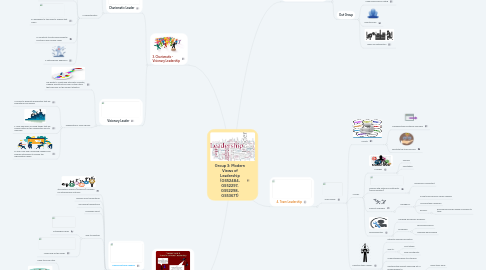
1. 3. Charismatic - Visionary Leadership
1.1. Charismatic Leader
1.1.1. An enthusiastic, self-confident leader whose personality and actions influence people to behave in certain way
1.1.2. 5 characteristics:
1.1.2.1. i. have a vision
1.1.2.2. ii. ability to articulate that vision
1.1.2.3. iii. willingness to take risks to achieve that vision
1.1.2.4. iv. sensitivity to both environmental constrains and follower reads
1.1.2.5. v. extraordinary behaviors
1.2. Visionary Leader
1.2.1. The ability to create and articulate a realistic, credible and attractive vision of the future that improves on the present situation
1.2.2. Organization's vision should:
1.2.2.1. i. be able to generate possibilities that are inspirational and unique
1.2.2.2. ii. offer new ways of doing things that are clearly better for the organization and its members
1.2.2.3. iii. offer clear and compelling imagery and inspires enthusiasm to pursue the organization's goals
2. 2. Transformational - Transactional Leadership
2.1. Transformational Leaders
2.1.1. Stimulates & inspires (transform) followers for extraordinary outcome
2.1.2. Develop from transactional
2.1.3. Go beyond transactional
2.1.4. Employee effort
2.1.5. Able to question
2.1.5.1. Established views
2.1.5.2. Views held by the leader
2.1.6. Evidence strongly correlated with
2.1.6.1. Lower turnover rates
2.1.6.2. Higher levels of productivity
2.1.6.3. Higher work engagement
2.1.6.4. Higher employee satisfaction
2.1.6.5. Higher creativity
2.1.6.6. Higher goal attainment
2.1.6.7. Higher follower well-being
2.2. Transactional Leaders
2.2.1. Exchanges rewards (transactions) for productivity
3. 1. Leader-Member Exchange (LMX)
3.1. In Groups
3.1.1. Higher performance rating
3.1.2. Less turnover
3.1.3. Greater job satisfaction
3.1.4. Engage in more helping
3.2. Out Group
3.2.1. Lower performance rating
3.2.2. High turnover
3.2.3. Lower job satisfaction
4. 4. Team Leadership
4.1. Team-leader
4.1.1. Priority
4.1.1.1. Managing team's external boundary
4.1.1.2. Facilitate the team process
4.1.2. 4 Roles
4.1.2.1. Coaches
4.1.2.1.1. Training
4.1.2.1.2. Facilitating
4.1.2.2. Liaisons with external constituents (communication)
4.1.2.2.1. Everybody is important
4.1.2.3. Conflict managers
4.1.2.3.1. Manage by:
4.1.2.4. Troubleshooters
4.1.2.4.1. Handling disciplinary problems
4.1.2.4.2. Reviewing
4.1.3. Effective team-leader:
4.1.3.1. Patiently sharing information
4.1.3.2. Able to:
4.1.3.2.1. Trust others
4.1.3.2.2. Give up authority
4.1.3.3. Understanding when to intervene
4.1.3.4. Mastered the difficult balancing art of knowing when to:
4.1.3.4.1. Leave team alone
4.1.3.4.2. get involved

